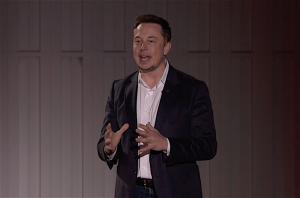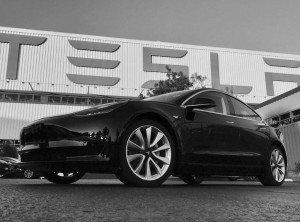
Tesla CEO Elon Musk said he believes the company will have 25% profit margins on its Model 3 by late 2018.
The company may still be operating in the red, but Tesla’s improved second-quarter financial report helps set the goal for aggressive production ramp-up that could give it industry-leading profit margins in little more than a year, CEO Elon Musk said during a Wednesday evening teleconference.
Musk said he has grown “very confident” about the future of the California-based automaker, especially as he watches a flood of orders rush in for the new Model 3 battery-electric vehicles that went into production last month.
Despite repeating a warning that the next six months could bring “manufacturing hell” for Tesla, the South African-born entrepreneur insisted it will pay off in the not-too-distant future. “People should have absolutely zero concerns – zero – that Tesla will be able to hit 10,000 vehicles a week by the end of next year.”
That would put it on track to meet its goal of producing 500,000 vehicles in 2018, including the new Model 3, as well as the older Model S sedan and Model X SUV. But the Model 3 is the vehicle that could turn Tesla’s long stream of red ink black, Musk suggesting that within three months of hitting that 10,000 unit target Tesla will start earning margins of 25% on the compact electric sedan.
For now, however, Tesla continued operating a deficit. In fact, it has turned a profit just twice since going public, and only then by using non-traditional accounting methods.
(Fear of “manufacturing hell” has investors unplugging from Tesla. Click Here for the story.)

A new Model 3 in front of Tesla's Fremont, California, plant, which began producing the new entry-level model last month.
The good news was that, for the second quarter of 2017, Tesla reported an adjusted loss of $1.33 a share, well below the $1.82 deficit analysts had anticipated, according to consensus numbers gathered by Thomson Reuters. Meanwhile, revenue jumped to $2.79 billion, while analysts had expected a figure of $2.51 billion.
The strong revenue came despite the fact that Tesla delivered fewer of its Models S and X during the quarter than it had original expected, a shortfall reflecting battery supply issues. On the other hand, vehicle deliveries were still up 53% year-over-year.
The second-quarter earnings appeared to be just the tonic needed as the company moves into the critical rollout of its Model 3 sedan. Tesla shares tumbled almost $70 in recent weeks from the record $383.45 closing it had hit on June 23. TSLA posted double-digit losses since late last week, in fact, despite the delivery of the first 30 Model S sedans during a splashy ceremony at the automaker’s Fremont, California, assembly plant.
Among other things, investors had been spooked by Musk’s warning that the production ramp-up of the Model 3 would be “manufacturing hell.” He didn’t back away from that on Wednesday eve, but also noted that, “I don’t think we should expect any significant surprises” that would set back Tesla’s ambitious production plans.
(Click Here for more about the delivery of the first 30 Tesla Model 3 sedans.)
Tesla is going to need to ramp up production as quickly as possible. Not only have most of the estimated 400,000 to 500,000 early reservations for the Model 3 been holding, but Musk revealed that Tesla is taking new orders at a rate of “about 1,80 a day.”
“If anybody orders a Model 3 today, it’ll be at least late next year before they get it,” he said.
At the Friday handover ceremony, Tesla provided a number of new details about the Model 3. While it has boasted about a $35,000 base price, such entry-level models won’t start rolling down the Fremont assembly line until autumn. For now, Tesla is focusing on more lavishly equipped models averaging around $44,000 each. And observers estimate that fully loaded, including a battery pack capable of topping 300 miles per charge, the Model 3 will top out at around $60,000.
While investors seem buoyed by the latest developments, not everyone is quite so upbeat. In recent days, Goldman Sachs set a mid-range target price for TSLA at just $180 a share. Meanwhile, Efraim Levy, the auto analyst at CFRA Research, reiterated his “Sell” recommendation.
(For more about the Tesla Model 3, Click Here.)
While Levy did give the carmaker some credit, noting, “positive fundamentals including the key Model 3 met its targeted production start,” he quickly warned that Tesla spending could sharply increase in the months ahead, forcing it to go to Wall Street again with another stock offering.
